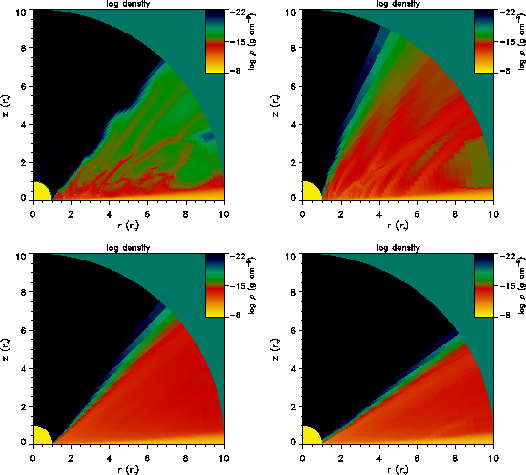
Radiation pressure on spectral lines drives powerful winds from massive, hot stars, and is expected to do the same for the inner regions of an accretion disk around a white dwarf, massive protostar, or perhaps even an AGN. In contrast to a stellar outflow, however, a disk wind is intrinsically two-dimensional rather than spherically symmetric. Thus, numerical hydrodynamical methods are required to compute the structure of radiatively-driven disk winds.
This work has been done in collaboration with Janet Drew (UCL), and Daniel Proga (GSFC).
By extending the ZEUS code to account for radiation pressure on optically thick spectral lines, a sequence of models has been computed in which both the luminosities of the disk and the central star are varied. The image below shows snapshots of the density at late times in four models. In the top two panels, the central star is assumed to be dark, and the luminosity of the disk is increased in the right panel compared to the left. In the bottom two panels, the luminosity of the disk is held fixed (and equal to the value used for the top right model) while the luminosity of the central star is increased.

Note that as the luminosity of the star is increased, the wind becomes increasingly equatorial, as expected. What is most unexpected is the complex structure of the wind evident when the radiation field is dominated by the disk component (upper left model). This complex structure is associated with an unsteady flow pattern that results from the competition between the nearly constant radiation force and the linearly increasing vertical component of gravity as the wind rises from the disk surface. The time-dependent evolution of the wind is best illustrated in this movie of the density for the model in the top left panel (the case where the disk contribution dominates the total luminosity of the system).
More details can be found in the following papers:
``Radiation driven winds from luminous accretion disks", by D. Proga, J.M. Stone, & J.E. Drew, Monthly Notices of the Royal Astronomical Society, 295, 595 (1998).